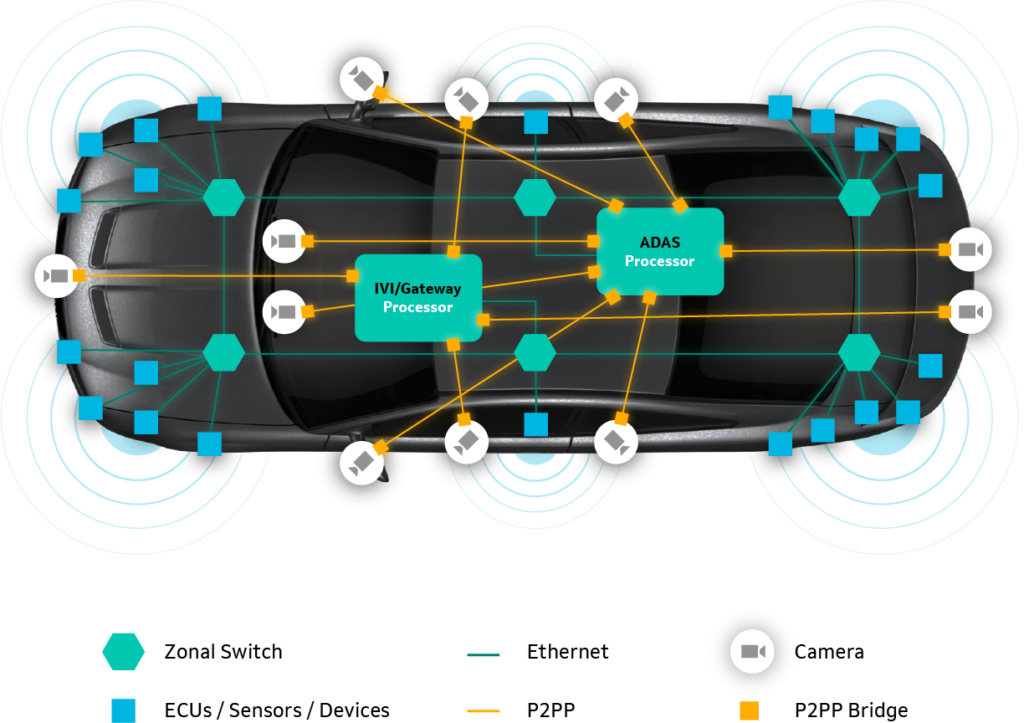- 产品
- 公司
- 支持
- 产品
Posts Tagged 'Automotive Ethernet PHY'
-
必不可少: 汽车互联互通史的过去和未来
By Amir Bar-Niv, VP of Marketing, Automotive Business Unit, Marvell and Mark Davis, Senior Director, Solutions Marketing, Marvell
In the blog, Back to the Future – Automotive network run at speed of 10Gbps, we discussed the benefits and advantages of zonal architecture and why OEMs are adopting it for their next-generation vehicles. One of the biggest advantages of zonal architecture is its ability to reduce the complexity, cost and weight of the cable harness. In another blog, Ethernet Camera Bridge for Software-Defined Vehicles, we discussed the software-defined vehicle, and how using Ethernet from end-to-end helps to make that vehicle a reality.
While in the near future most devices in the car will be connected through zonal switches, cameras are the exception. They will continue to connect to processors over point-to-point protocol (P2PP) links using proprietary networking protocols such as low-voltage differential signaling (LVDS), Maxim’s GMSL or TI’s FPD-Link.
-
By Amir Bar-Niv, VP of Marketing, Automotive Business Unit, Marvell
In the classic 1980s “Back to the Future” movie trilogy, Doc Brown – inventor of the DeLorean time machine – declares that "your future is whatever you make it, so make it a good one.” At Marvell, engineers are doing just that by accelerating automotive Ethernet capabilities: Earlier this week, Marvell announced the latest addition to its automotive products portfolio – the 88Q4346 802.3ch-based multi-gig automotive Ethernet PHY.
This technology addresses three emerging automotive trends requiring multi-gig Ethernet speeds, including:
- The increasing integration of high-resolution cameras and sensors
- Growing utilization of powerful 5G networks
- The rise of Zonal Architecture in car design
-
By Amir Bar-Niv, VP of Marketing, Automotive Business Unit, Marvell and John Bergen, Sr. Product Marketing Manager, Automotive Business Unit, Marvell
Some one hundred-and-sixty years later, as Marvell and its competitors race to reinvent the world’s transportation networks, universal design standards are more important than ever. Recently, Marvell’s 88Q5050 Ethernet Device Bridge became the first of its type in the automotive industry to receive Avnu certification, meeting exacting new technical standards that facilitate the exchange of information between diverse in-car networks, which enable today’s data-dependent vehicles to operate smoothly, safely and reliably.
-
By Amir Bar-Niv, VP of Marketing, Automotive Business Unit, Marvell
The roots of Ethernet technology began in 1973, when Bob Metcalfe, a researcher at Xerox Research Center (who later founded 3COM), wrote a memo entitled “Alto Ethernet,” which described how to connect computers over short-distance copper cable. With the explosion of PC-based Local Area Networks (LAN) in businesses and corporations in the 1980s, the growth of client/server LAN architectures continued, and Ethernet started to become the connectivity technology of choice for these networks. However, the Ethernet advancement that made it the most successful networking technology ever was when standardization efforts began for it under the IEEE 802.3 group.
最近推文
- HashiCorp and Marvell: Teaming Up for Multi-Cloud Security Management
- Cryptomathic and Marvell: Enhancing Crypto Agility for the Cloud
- The Big, Hidden Problem with Encryption and How to Solve It
- Self-Destructing Encryption Keys and Static and Dynamic Entropy in One Chip
- Dual Use IP: Shortening Government Development Cycles from Two Years to Six Months
档案文件
类别
- 5G (12)
- AI (11)
- 汽车 (26)
- Cloud (7)
- Coherent DSP (2)
- 公司动态(100)
- Custom Silicon Solutions (1)
- 数据中心(39)
- Data Processing Units (22)
- Enterprise (25)
- ESG (6)
- 以太网适配器和控制器(12)
- Ethernet PHYs (4)
- Ethernet Switching (30)
- Fibre Channel (10)
- Marvell Government Solutions (2)
- 网络 (31)
- Optical Modules (9)
- Security (3)
- Server Connectivity (15)
- SSD Controllers (6)
- 存储 (22)
- Storage Accelerators (2)
- What Makes Marvell (21)
- Coherent DSP (3)
- 公司动态(3)
- Optical Module (3)
- PAM4 DSP (3)
- Security (3)


